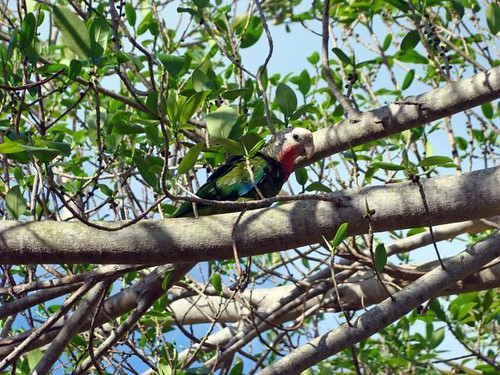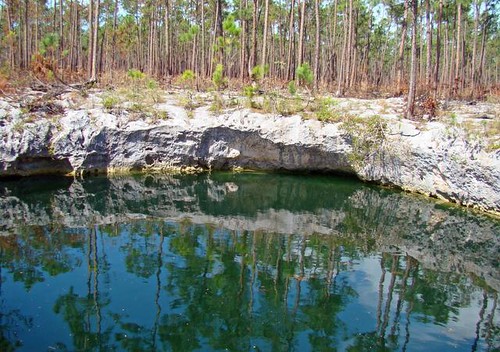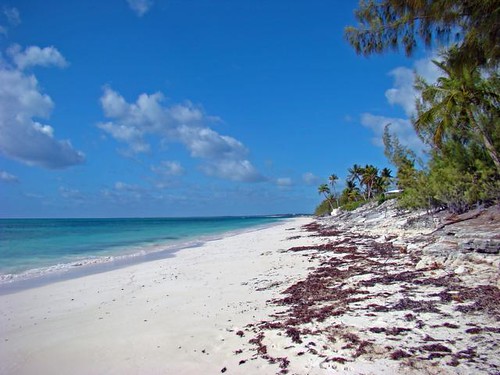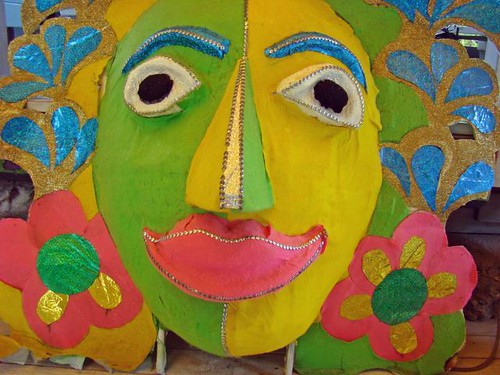 The lime-green Abaco parrot isn't easy to find, since the birds nest in the ground, or six feet under in limestone caves. We got lucky. Image by Diane BairABACO, Bahamas -- The first thing you should know if you go exploring the interior of Great Abaco Island is that nobody does this. Nobody. In spite of the fact that there are more than 200 species of birds — five found only in the Bahamas — plus dozens of “blue holes” and a lovely national park, you will be a sight more rare than the Abaco parrot if you venture away from the beach.
The lime-green Abaco parrot isn't easy to find, since the birds nest in the ground, or six feet under in limestone caves. We got lucky. Image by Diane BairABACO, Bahamas -- The first thing you should know if you go exploring the interior of Great Abaco Island is that nobody does this. Nobody. In spite of the fact that there are more than 200 species of birds — five found only in the Bahamas — plus dozens of “blue holes” and a lovely national park, you will be a sight more rare than the Abaco parrot if you venture away from the beach.
Blame the water. The ocean that laps the 120-mile-long island chain is so many shades of cerulean that even the Pantone paint people would have trouble naming them all.
“It’s really all about the water here,” says Andrew Sweeting, owner/general manager of the Abaco Beach Resort. Guests at the resort either come by boat, or rent one when they arrive, the better to explore crescents of pale blonde beach that rim the Abacos. And then there’s the lure of famous beach bars like Cracker P’s, Pete’s, and Nipper’s, where life is a Jimmy Buffett fantasy of conch fritters, rum punch, sun and sand.
You could spend $200 on a power boat rental and go island-hopping in search of the ultimate Goombay Smash. Or, you could spend it on a half-day eco-tour with guide Reggie Patterson, who will show you a very different slice of Bahamian life, one with birds and blue holes as opposed to bars and bikinis.
If you opt for the power boat, here’s a look at what you missed.
Rare birds, Blue holes
 Among Great Abaco Island's natural wonders: a blue hole thought to be 100 feet deep, part of a huge underground cave system. Image by Diane BairWe’re not big birders, but the idea of finding that mysterious parrot was curiously appealing. Arriving on the island, we asked our immigration agent if he’d seen the Abaco parrot. “No,” he said, muttering what was probably Bahamian slang for “weirdo!”
Among Great Abaco Island's natural wonders: a blue hole thought to be 100 feet deep, part of a huge underground cave system. Image by Diane BairWe’re not big birders, but the idea of finding that mysterious parrot was curiously appealing. Arriving on the island, we asked our immigration agent if he’d seen the Abaco parrot. “No,” he said, muttering what was probably Bahamian slang for “weirdo!”
Then we asked Sweeting, who grew up on these islands, if he’d ever encountered the bird. “Yes,” he said. “I was going to a business meeting in town, and two of them landed right on me.” Realizing we really wanted to see the parrot, Sweeting connected us with Patterson, who guides eco-tours. “I’ll show you that bird” Patterson, an eighth-generation Bahamian, declared.
The first thing we learned as we headed out to find the rare Abaco parrot was, it’s not so rare on this island. It’s not even endangered. Although the green, squawky birds were once found on five or six islands, they now inhabit only Abaco and Inagua, Patterson says. There are roughly 3,000 of them on Abaco alone, he says, but they’re not easy to find, given that they nest in the ground, sometimes six feet down in limestone caves.
Besides the parrot, Great Abaco is home to five species seen no place else in the world, and more than 200 species total. Patterson himself has 170 birds on his Abaco list. Wouldn’t that make this island, and its neighbors, irresistible to the birding crowd? Not really.
“Birders haven’t really discovered us yet,” Patterson says, in spite of the endemic species like the Bahama warbler, and the large number of migrant birds from eastern North America that escape the winter here. But the news is good: “Native birds seem to be on the upswing,” Patterson says, and he’s getting more inquiries for his guiding business.
So we’d be going deep into the wilderness in search of the parrot? Why, no. They seem to prefer the suburbs. “There’s a flock that always seems to be at Bahama Palm Shores,” Patterson said, driving down a road lined with Caribbean pines. En route, we heard the calls of a red-winged blackbird and bananaquit.
 The beaches on Great Abaco Island are so lovely and unspoiled that few visitors head into the interior of the island, where parrots and blue holes await. Image by Diane Bair.We parked in a residential area and walked into a backyard with a nice garden, where “the owners are used to birders enjoying their gardens,” Patterson said. Almost instantly, we heard squawking. A lime-green parrot flew over our heads into a fig tree and, as we pulled out our cell-phone cameras, four more zipped right over our heads, a cacophony of squawks.
The beaches on Great Abaco Island are so lovely and unspoiled that few visitors head into the interior of the island, where parrots and blue holes await. Image by Diane Bair.We parked in a residential area and walked into a backyard with a nice garden, where “the owners are used to birders enjoying their gardens,” Patterson said. Almost instantly, we heard squawking. A lime-green parrot flew over our heads into a fig tree and, as we pulled out our cell-phone cameras, four more zipped right over our heads, a cacophony of squawks.
“It’s amazing where you can go to see birds,” our guide said. “Garbage dumps are a great place to go, but who wants to go there?” Indeed.
Back in the car, we headed south, past scrub and skinny pines, to a long dirt road. As we bumped along, Patterson pointed out a Lasagra’s flycatcher. We heard the calls of a pine warbler and a Bahama yellow throat, species that would surely make a birding enthusiast swoon.
Then we discovered another of the island’s natural wonders: a blue hole thought to be 100 feet deep. The giant pool, surrounded by brush, is the opening of a huge cave system right under our feet, Patterson said.
“A lot of interesting stuff has come out of here,” he added, like the skeletons of birds now extinct, and the remains of ancient Cuban crocodiles.
We’d worn swimsuits under our clothes but weren’t tempted to jump into the water.
“Swimming in a blue hole can be kind of creepy,” Patterson said, alluding to a toxic layer, blind cave fish, and other features that would tempt only a committed cave diver, or maybe a contestant on a reality show.
A rarity
 This junkanoo mask is part of the colorful jumble of "decor" at Pete's Pub, a tiki hut on Abaco. Image by Diane BairOur next stop was an unfinished resort development at Gilpin Point Pond that’s home to a flock of Bahamas pintail ducks. These rarities are found only here and on Cuba and Hispaniola, but no place in the U.S. Along a clump of mangroves, we also spotted several black necked stilts and a tri-colored heron.
This junkanoo mask is part of the colorful jumble of "decor" at Pete's Pub, a tiki hut on Abaco. Image by Diane BairOur next stop was an unfinished resort development at Gilpin Point Pond that’s home to a flock of Bahamas pintail ducks. These rarities are found only here and on Cuba and Hispaniola, but no place in the U.S. Along a clump of mangroves, we also spotted several black necked stilts and a tri-colored heron.
Why is this island so rich with bird life? A variety of habitats sets Abaco apart, Patterson says. “Abaco has the inland sea, the pine forest — which most islands don’t — broadleaf forest, and mangrove islands,” he explains. In addition, much of the inland is wild land; most of the development is along the coastline. “I believe we should let the forest be. There’s no need for development here.”
Decision time: Should we continue our Tour de Parrot at Abaco National Park, a 20,000-acre pine forest that’s a nesting ground and habitat for the Abaco parrot? Or should we bag the bird thing and go searching for lunch? Hmm. We’d seen that loud green bird, and got the pictures to prove it. So it was time to toast our success with a rose-hued rum drink and a golden pile of conch fritters. Tomorrow, we’ll sleuth out a different species: Johnny Depp, who’s said to have a home on one of these islands.